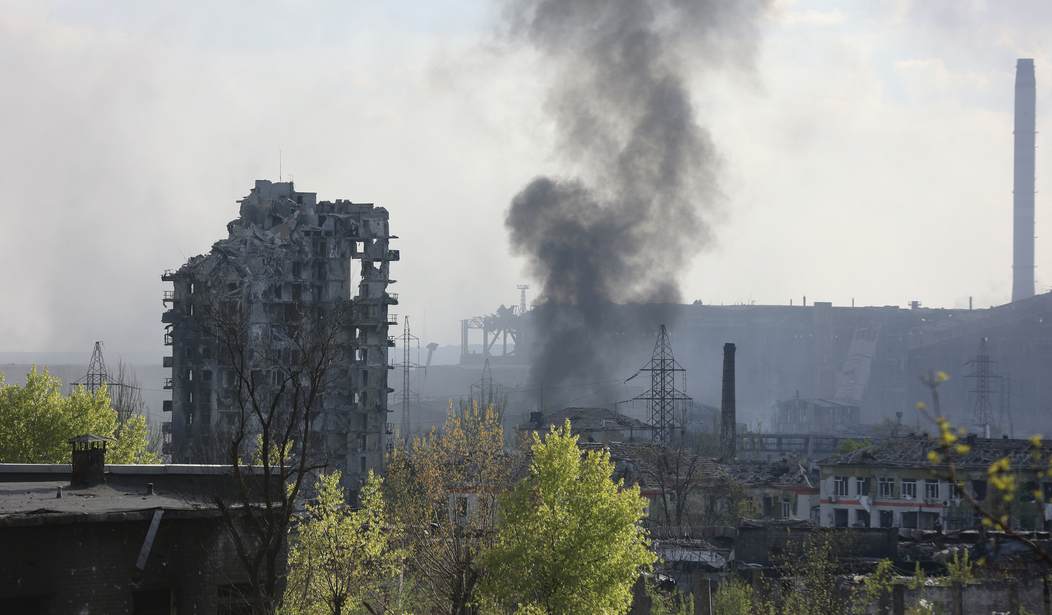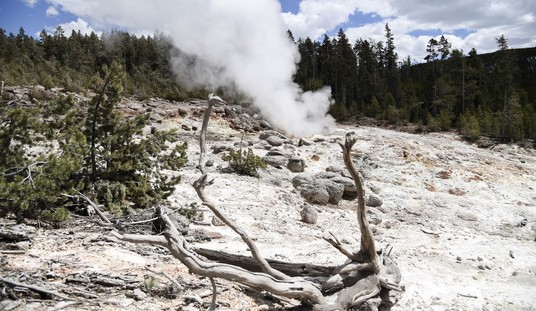Tuesday, a Russian airbase in occupied Crimea was ripped by massive explosions. The airbase was 165 miles from Odesa, the nearest Ukrainian-controlled territory. The Russians say there is nothing to see, just a routine ammunition explosion. The Ukrainian statement is a bit more obtuse, “a device exclusively of Ukrainian manufacture was used.”
Video of the explosions at Saki Airbase in Crimea. https://t.co/zLUtyx4PI7 pic.twitter.com/wvBAboSPmC
— Rob Lee (@RALee85) August 9, 2022
Video clearly showing two large explosions happening exactly simultaneously at two different locations. They happened simultaneously to the second.
Afterwards a third large explosion is seen. pic.twitter.com/OC0OIyaWUD
— Oliver Alexander (@OAlexanderDK) August 9, 2022
#Ukraine There have been reports of explosions at the Russian air base in the Crimean Novofedorivka pic.twitter.com/350C1yA2to
— Hanna Liubakova (@HannaLiubakova) August 9, 2022
The moment of one of the explosions. 11/https://t.co/HFbJXmBQLq pic.twitter.com/N6vB3bV2Ml
— Rob Lee (@RALee85) August 9, 2022
📽️Locals report up to ten explosions at the Novofedorivka airbase, occupied #Crimea. #UkraineRussiaWar pic.twitter.com/BzGnQJCdc0
— MilitaryLand.net (@Militarylandnet) August 9, 2022
The airfield is the most important airbase in Crimea and is the source of many of the sorties flown against Ukrainian forces. Satellite imagery in the hours before the attack showed over 20 aircraft there.
⚡️Ukrainian investigative news project Skhemy published satellite images of a Russian military base near #Novofedorivka in #Crimea. According to these images, there were apparently Il-76, 10 Su-30 and 12 Su-24 at the airfield this morning.
📷 via @cxemu pic.twitter.com/OWqjwbOfUo
— The Ukrainian Week (@ukr_week_en) August 9, 2022
Emerging video shows two and possibly three destroyed Su-24 Fencer all-weather attack aircraft but it in no way provides anything like battle damage assessment.
The blast damaged buildings nearly a mile away from the impact area.
1 km away from the #Novofedorivka airfield…imagine how the airfield looks 😏😏😏#CrimeaIsUkraine #StopRussiaNOW #UkraineWillWin pic.twitter.com/LRb2xCAYMj
— ꑭ Natalia ꑭ (@NatalieSmal) August 9, 2022
Incredible amounts of damage at Novofedorivka airbase in Crimea. pic.twitter.com/ymFh7HUxDX
— OSINTtechnical (@Osinttechnical) August 9, 2022
There are reports of a massive traffic jam forming at the Kerch Bridge that spans the Kerch Strait separating Russian territory from occupied Crimea. The tweet is wrong about the distance, which is why you don’t take anything at face value.
People are trying to leave Novofedorovka after a series of explosions — Traffic jams on outskirts of the village, сolumns of emergency vehicles are heading from #Yevpatoria#Crimea #Russia pic.twitter.com/mOVIGGCoin
— Readovka World (@ReadovkaWorld) August 9, 2022
So what caused the explosions?
I think it is safe to rule out any kind of “industrial accident” scenario such as the Russians are trying to spin. There have been disasters like this (see Texas City and Port Chicago) in the past, but the nature of the blasts indicates they were caused deliberately.
As an Army guy, I’d like to make a case for partisan forces led by Ukrainian special forces. I think the simultaneous explosions and the location and type of target mitigate against people being able to get in and out of multiple ammunition storage facilities without a “close encounter of the worst kind.”
An air strike using precision-guided munitions is a possibility but unlikely. The air defense environment in the area around this air base and other military facilities in occupied Crimea is intense. No missiles were fired in defense, and there was no jet aircraft sound. The odds of non-stealth aircraft getting close enough to carry out this attack without being detected and engaged seem, to me, to be remote.
This video shows two identical massive explosions that happened at almost the same moment in two different parts of the Russian Saki airbase in occupied Crimea. This is the best proof of a missile strike. Probably GPS-guided missiles hit ammo depots pic.twitter.com/D8ZMUcmOXB
— Sergej Sumlenny (@sumlenny) August 9, 2022
If we are talking about a precision strike by missiles, the field is narrowed down to the available systems with the necessary range to carry out this attack. Two systems that can execute this attack, the Hrim 2 short-range ballistic missile and Korshun cruise missile, are, as far as we know, not ready for service.
Army Tactical Missile System (ATACMS)
As far as we know, ATACMS is not in theater, but it is launched from the M-270 MLRS and M-142 HIMARS, and this has caused speculation that it was used. Ukraine has requested this missile, but the request was denied. I’m only bringing it up because I’ve seen a lot of claims that this was an ATACMS strike. An ATACMS strike would look a lot like this. What mitigates against ATACMS is that there was no activation of air defense systems. Either everyone was drunk on airplane de-icer, or we need a different explanation.
OTR-21 Tochka
A possible candidate is the OTR-21 Tochka, known to NATO as the SS-21 Scarab. It is a short-range ballistic missile, but today’s strike was well within its operational radius. The simultaneous impacts are technically possible with the Tochka. What is missing is the sound. An inbound Tochka is supersonic and has a considerable sound signature. Like the ATACMS, its arrival should’ve triggered air raid warnings and been engaged by surface-to-air missiles. The S-400 system, which is like a mentally challenged version of Patriot, is theoretically capable of engaging these missiles.
R-360 Neptune Cruise Missile
The Neptune cruise missile leaped upon the world stage in April when it was credited with sinking the flagship of Russia’s Black Sea Fleet, the Moskva; see BREAKING. Russian Flagship Sinks While Being Towed to Port.
Originally designed as an anti-ship missile, it has been upgraded to increase the range, and an inertial guidance package installed that lets it be used in a land attack mode. It has a range of approximately 180 miles.
Three things lead me to believe that Neptune was used. The simultaneous impacts are a hallmark of cruise missile targeting; Neptune’s flight profile is about 15 feet above the ground, and it would not have triggered air defense systems, and the statement by the anonymous Ukrainian official that the weapon used was made in Ukraine.
Impact
We’ll have to wait a few days to see how this shakes out. We’ll know much more about the damage inflicted after commercial satellites make another pass. It could be Russia’s largest one-day loss of aircraft since World War II. The Russian reaction so far has been mixed. The official reaction from Moscow says this was an accident. Russian entertainment and social media figures have a different view.
Russian state media personalities seem genuinely taken aback by the blasts just now in Crimea (reportedly at a military airfield)
Olga Skabeyeva says the attack was "completely over the top"
Margarita Simonyan writes "Again. Where are you, red line?"
— Francis Scarr (@francis_scarr) August 9, 2022
Putin's propagandist Skabeeva publishes a video of the result of the Ukrainian Armed Forces strike on a military airfield in Crimea and comments that "this is already too much" That is, bombing and firing rockets at Ukrainian cities is normal, but what about a Russian military? pic.twitter.com/5tw9C9tZEd
— Alf Really (@vik8867dn) August 9, 2022
The political implications of what happens next are significant. If Russia officially refuses to acknowledge the attack when its propagandists have, it loses credibility. If it acknowledges the attack and doesn’t do something big, it has basically countenanced the expansion of the theater of war to include Ukraine and tacitly admitted Crimea is not really part of Russia.
Looks like a complete blackout in the Russian telegram channels on the Crimea explosions in the last 30 minutes or so – waiting for the "official version" to land from above.
— Dmitri (@wartranslated) August 9, 2022
It is going to be an interesting week or two.














Join the conversation as a VIP Member